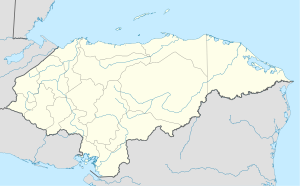San Pedro Sula, Honduras
|
San Pedro Sula "Usula (Valley of Birds)" |
|||
|---|---|---|---|
|
|||
| Nickname(s): La Capital Industrial,Sap |
|||
| Coordinates: 15°30′0″N 88°2′0″W / 15.50000°N 88.03333°WCoordinates: 15°30′0″N 88°2′0″W / 15.50000°N 88.03333°W | |||
| Country |
|
||
| Department | Cortés | ||
| Municipio (County) | San Pedro Sula | ||
| Foundation | 27 June 1536 | ||
| Government | |||
| • Mayor | Armando Calidonio Alvarado (PNH) | ||
| Area | |||
| • City | 898 km2 (347 sq mi) | ||
| Elevation | 83 m (272 ft) | ||
| Population (2013 census) | |||
| • City | 719,063 | ||
| • Density | 800/km2 (2,100/sq mi) | ||
| • Metro | 1,445,598 | ||
| Time zone | Central America (UTC−6) | ||
San Pedro Sula (Spanish pronunciation: [sam ˈpeðɾo ˈsula]) is the capital of Cortés Department, Honduras. It is located in the northwest corner of the country in the Sula Valley, about 100 kilometres (62 mi) south of Puerto Cortés on the Caribbean Sea. With a census population of 719,063 in 2013, and 1,445,598 people living in its metropolitan area in 2010, it is Honduras's second largest city after the capital Tegucigalpa.
The city grew slowly from about 800 residents in 1590, to almost 10,000 by the 1890s, but most of this population growth took place in the 19th century. It benefited initially from the growth of bananas for export in the 1870s and 1880s and formed a close relationship with US based shipper and railroad entrepreneur Samuel Zemurray's Cuyamel Fruit Company, and the construction of the Interoceanic Railroad between 1869 and 1874 which connected the city to the coast at Puerto Cortés. Zemurray worked closely with local elites who invested in subsidiary enterprises and thus shaped the way politically for Cuyamel to establish itself and, along the way to pay very few taxes.
Panoramic view of Downtown San Pedro Sula.
Municipal Palace.
In 2013, fifteen years after the effects of Hurricane Mitch, Honduras is one of the poorest countries in Latin America; around San Pedro Sula, banana production has not fully recovered, and "manufacturing has all but dried up." The problems are exacerbated by organised crime, whose rules prevent residents from safely leaving gang-controlled neighbourhoods such as Chamelecón for jobs in other parts of town.
In 2000, then-Mayor Roberto Larios Silva said "San Pedro Sula is where the economic development of the country is concentrated via the city's industrial, commercial and financial development." The then-manager of Hotel Copantl attributed its growth in business-related tourism ...[to] the maquila (apparel manufacturing) industry.
...
Wikipedia



